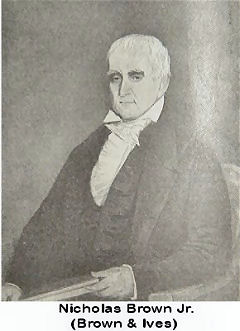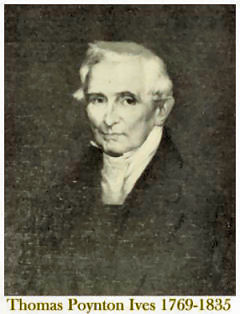![]()
Postal History Introduction
Stampless
Covers
1846
to 1900 Issues
1901-1950
Issues
1951-2003
Issues
Cancels
&
Miscellaneous
Postal
Stationery
Post
Cards
Air
Mail
First
Day &
Event Covers
Parcel Post/Special Delivery
Registered & Official Mail
Commercial & Advertising
Revenue & Postage Due
Wildlife & Game Issues
Complete List of RI Issues
|
Rhode Island Stampless
Covers & Letters |
|
Nicholas
Brown, Jr. Nicholas was a member of the Rhode Island General Assembly for many years and one of the electors for the state of Rhode Island. He was one of the original founders of the Athenaeum and a major benefactor of Rhode Island College. He was elected as a trustee of the college in 1791 and performed the duties of treasurer for over 29 years. Nicholas began his contributions to the college in 1792 with a gift of $500.00 and in 1804 he donated a gift of $5000.00. His brothers were also strong supporters of the college and the college voted in that year to change the name to Brown University in honor of the family's generosity and support. In 1822, Nicholas paid for and built another hall for the University which was named "Hope College" after his sister Hope Ives. He continued to contribute funds and material to the university until his death in 1841. Nicholas Brown married
Anne Carter
on November 3, 1791.
Nicholas and Anne had 6
children; one of whom,
John Carter Brown,
took over the management of
Brown and Ives on his
father's death. Anne died
on June 16, 1798
and Nicholas married Mary
Bowen on
July 22, 1801. Nicholas
died
in Providence, RI on
September 27, 1841. |
|
Thomas Poynton
Ives Thomas rose through the company ranks and by 1791, he was in charge of most of the company's affairs. In 1792, Thomas married Nicholas' only daughter Hope Brown and entered into a partnership with Nicholas Jr. Thomas was heavily involved in the firm's shipping business and the success of the company's Far Eastern trade was largely due to his efforts. Thomas also
introduced
the concept
of using fleets of small vessels in foreign countries to take
lesser cargos from the larger ports to the smaller markets and
then return to the central port and load the bigger company
vessels, which would enter the major ports at pre-stated times.
Brown and Ives
was the first
Rhode Island firm to
introduce this
method.
Thomas Ives remained active in the company's affairs until his
death in 1835.
In 1811
he was appointed as the President of the
"Providence Bank"
and in 1819
he he became President
of the "Providence Institute
for Savings,"
(The Old Stone Bank). |
|
|
John Carter
Brown John had developed a love of rare and unusual books and he began collecting books and publications very early in life. He traveled abroad in 1841; spending several years in the capitals of Europe where he continued to acquire books for his collection. His collection included the most complete library on American History in the country. John became a trusty of Brown University in 1828 and was selected as a fellow in 1842. Following in his father's footsteps; he gave generously to the University. His donations of funds and land to Brown University included the library which was subsequently named after him. He also donated funds and gifts to other colleges and schools throughout the country. He was one of the original founders of the Butler Hospital for the Insane and continued to support the institution throughout his lifetime. He was also a major contributor to the Rhode island hospital and served as president of the New England Emigrant Aid Society. John married Sophia Augusta Browne of Great Britain in May of 1859, (a direct descendent of Roger Williams). They had three children; John Nicholas, Harold, and Sophia Augusta. John Carter Brown died in Providence, Rhode Island on June 10, 1874. NOTE: During my previous research, I had thought that the firm of Brown and Benson became Brown and Ives in 1792, however during my research for the 1799 Brown, Benson and Ives Stampless Folded Letter, I discovered that Thomas Poynton Ives became a partner in 1792, however George Benson did not leave the firm until 1796. Thus the firm was known as Brown, Benson and Ives during the period 1792 to 1796. |
|

RI Historical
Society
Introduction
Stampless I
Stampless II
Stampless III
Stampless IV
Stampless V
Stampless VI
Brown & Ives Letters
The Hazard Family Letters
Joseph Tillinghast
Free Franked Letters
DeWolf Family Letters
Recently Added Pages
Return to 1793
Cover

